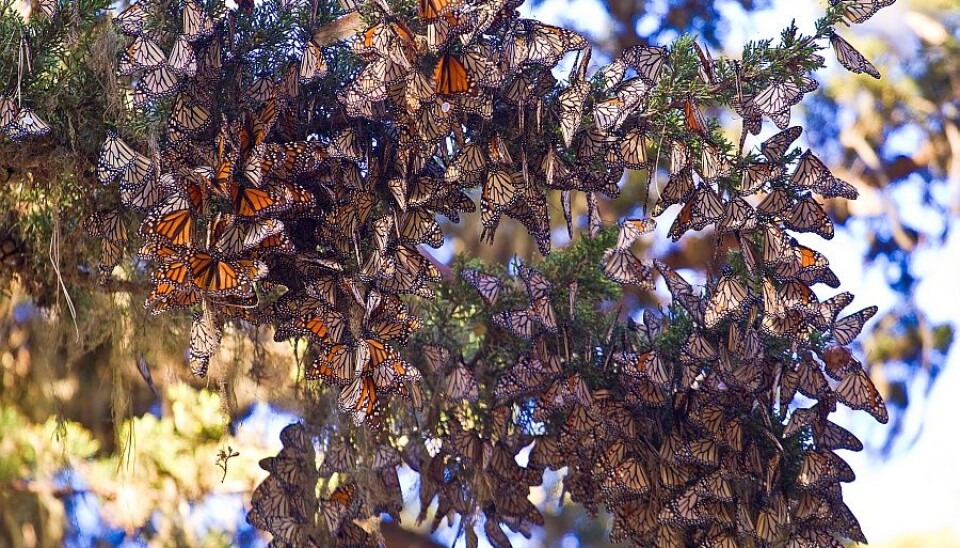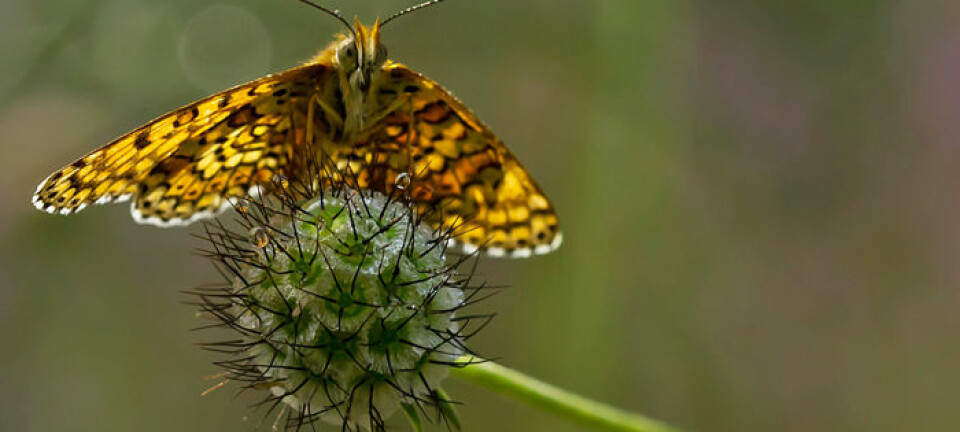
Butterflies fly 3,500 km by compass
Monarch butterflies fly from Canada to Mexico using only an internal compass and the landscape to guide them. Now researchers can explain how.
The annual migration of the monarch butterfly is one of nature’s greatest mysteries and miracles.
When winter arrives in Canada and the US, the monarch butterfly (Danaus plexippus) migrates south and overwinters in a Mexican mountain range a staggering 3,500 kilometres further south.
Here they form groups so large and dense that they can cover entire trees.
Butterflies end up in grandparents’ favourite trees
Now two Danish researchers, together with their Canadian colleagues, can explain for the first time how the butterflies manage to find their way from Canada to Mexico when in reality they don’t have the faintest idea where in the world they are.

”The butterflies have an internal solar compass, which guides them to the southwest in the autumn. At the same time, the monarch butterflies follow a natural geographical funnel, formed by the Rocky Mountains to the west and the Mexican Gulf to the east,” says Henrik Mouritsen, a Danish professor at the Research Center for Neurosensory Sciences, University of Oldenburg, Germany.
“In this way, they end up perching on the exact same trees that were visited by their ancestors in previous years – four to five generations earlier. It’s astonishing that a strategy as simple as this one could possibly work.”
The researchers’ findings are published in the journal PNAS.
Butterflies have no internal map
When the butterflies migrate south towards Mexico in winter, they are doing so for the first time. They simply do not know where they’re heading and what their goal is.
Researchers have previously proposed that the butterflies use a compass and an inborn internal map to help them navigate the long journey.
But the new findings partly disprove this theory:
“We can clearly dismiss the idea that the butterflies are following an internal map. When we moved the butterflies 2,500 kilometres to the west, from Ontario to Alberta, they still flew in the same southwestern direction that they would have done had they not been moved,” says Mouritsen.
“They do not correct their direction to compensate for the change of location. They have no idea where they are.”
Butterflies in flight simulator
To study the butterflies’ direction of flight, Mouritsen and his colleague Professor Barrie Frost of Queens University, Canada, developed a flight simulator that enables them to position the butterflies so their direction of flight can be measured hour by hour.
The experiment revealed that regardless of where in North America the researchers placed the butterflies, they always flew in the same direction and not towards the same target.
“If the butterflies have an internal map, this should have an effect on their direction of flight when they are moving in a direction that will never lead them to Mexico.”
So how do butterflies navigate the world?
Having no internal map, the butterflies need to find alternative routing information to find their way to Mexico.
Here, the new study shows that geography lends a helping hand:
From Canada to Mexico, the Atlantic Ocean and the Caribbean Sea to the east and the Rocky Mountains to the west form a natural funnel, which the butterflies follow all the way to their winter residence.
”It’s pretty clever: the butterflies don’t like flying over water or mountains. This means that as long as their direction is fairly correct – i.e. southwest in autumn – they will either follow the US East Coast or the Rocky Mountains until they reach their winter destination in the Trans-Mexican mountains, which extend across all of Mexico,” says the professor.
“In other words, they don’t really need a map at all to find their way.”
When the butterflies head back north after having spent the winter in Mexico, their direction is far less precise, which is why they are spread out across the entire North American continent.
-------------------------
Read the Danish version of this article at videnskab.dk
Translated by: Dann Vinther






